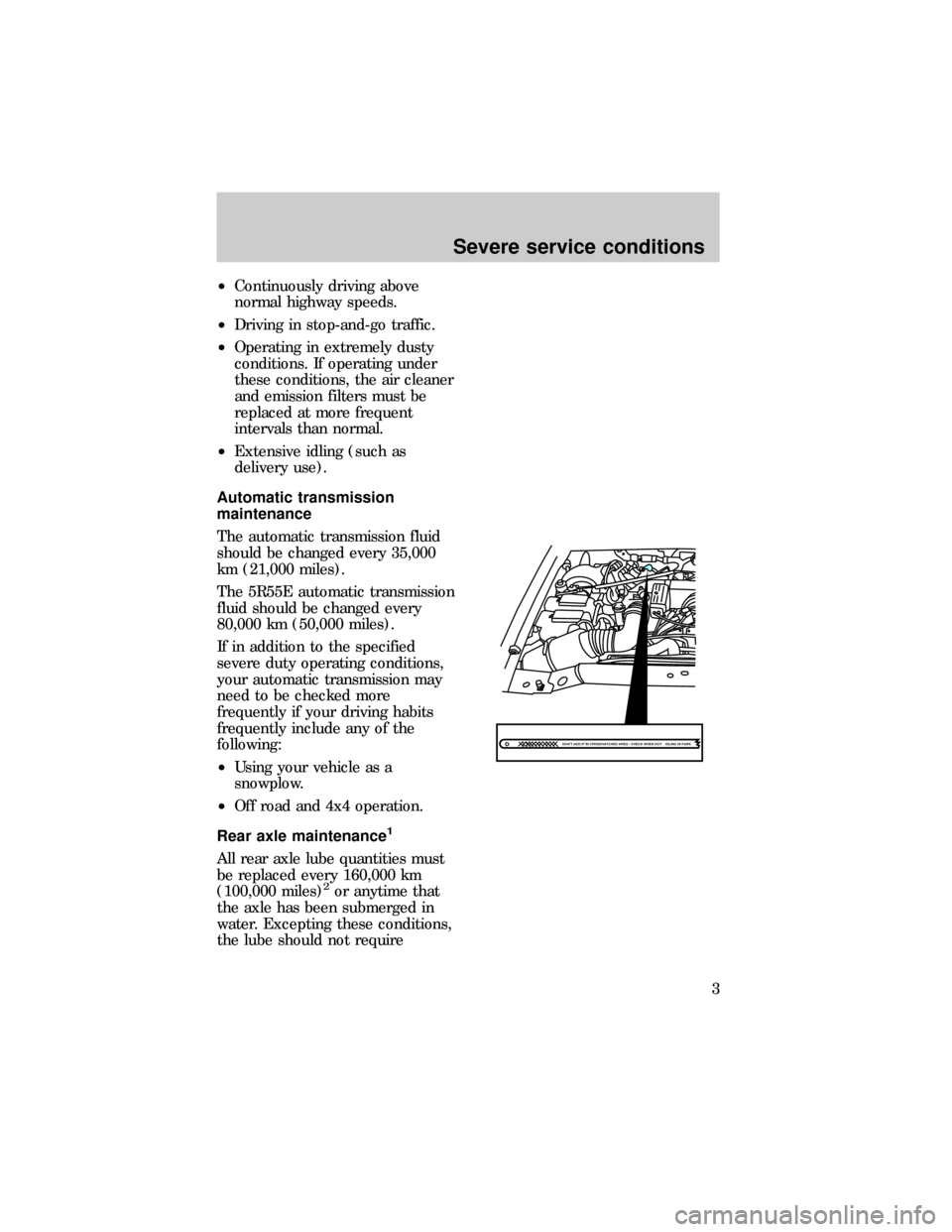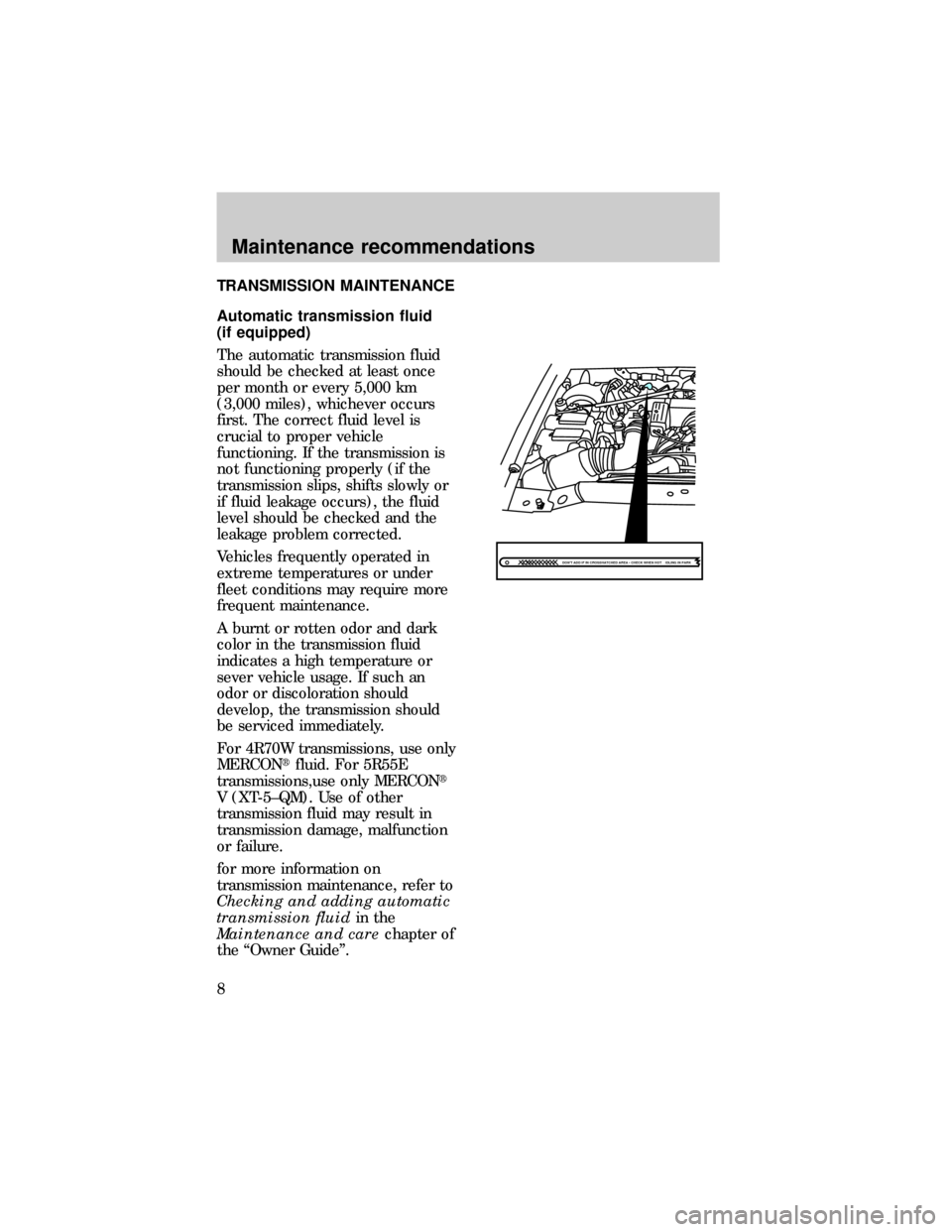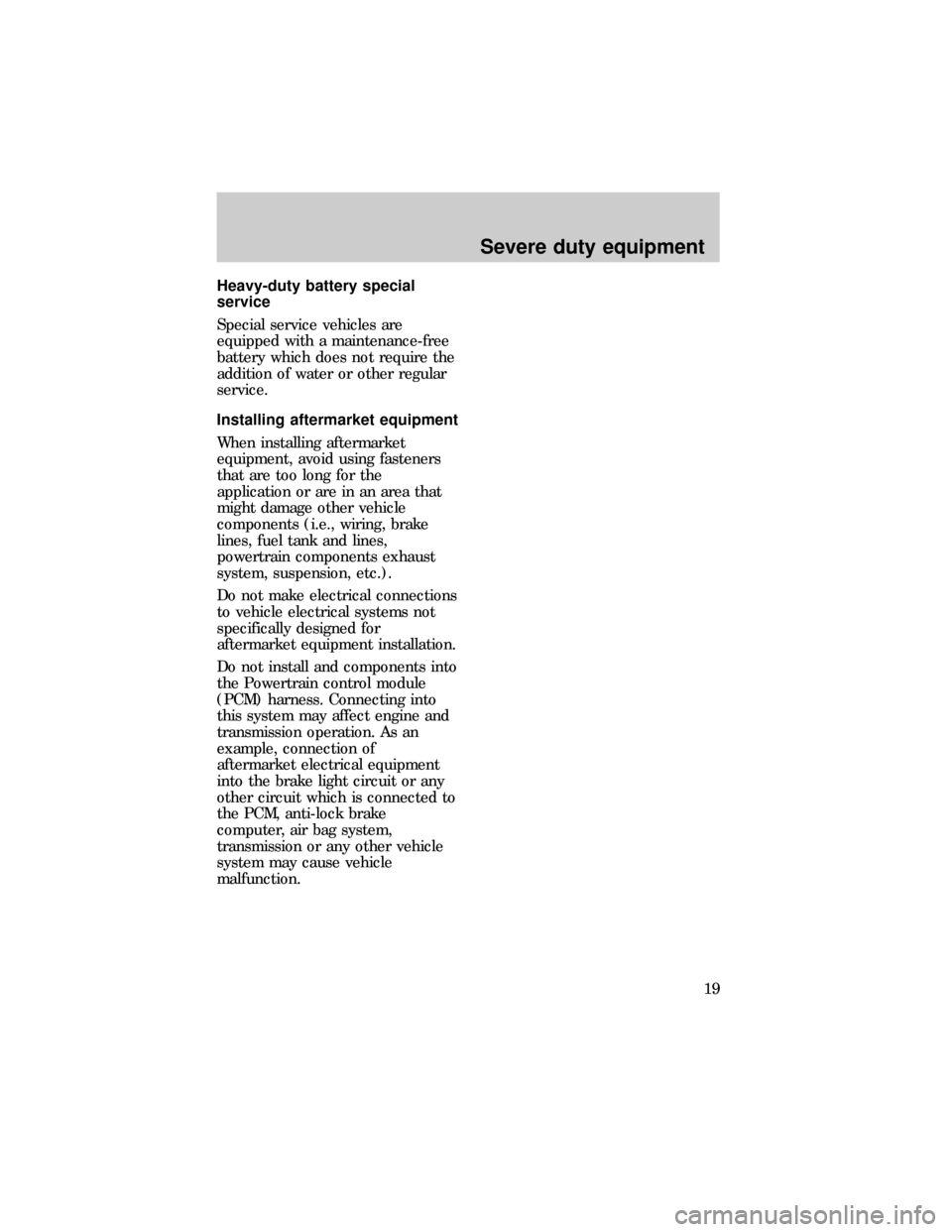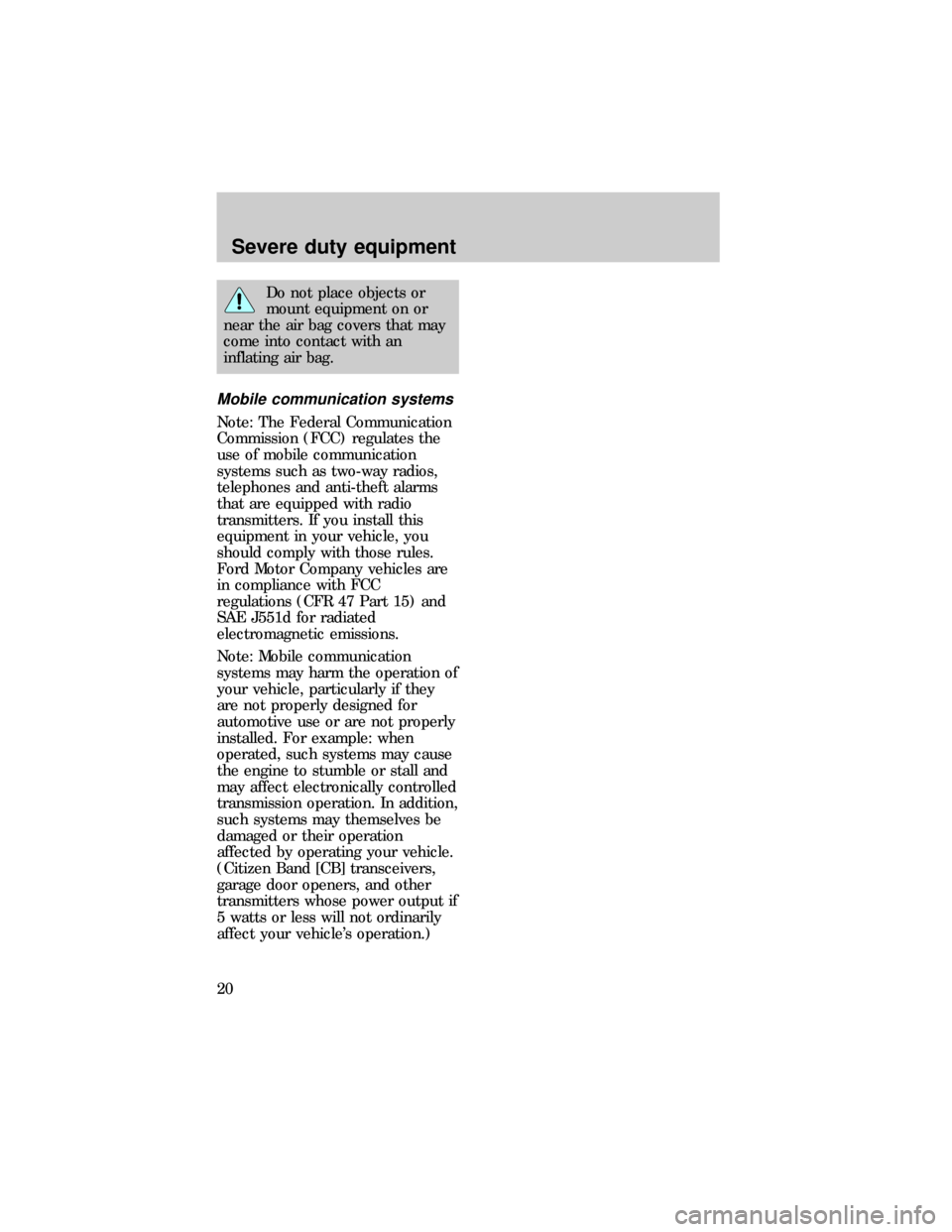Page 3 of 28

²Continuously driving above
normal highway speeds.
²Driving in stop-and-go traffic.
²Operating in extremely dusty
conditions. If operating under
these conditions, the air cleaner
and emission filters must be
replaced at more frequent
intervals than normal.
²Extensive idling (such as
delivery use).
Automatic transmission
maintenance
The automatic transmission fluid
should be changed every 35,000
km (21,000 miles).
The 5R55E automatic transmission
fluid should be changed every
80,000 km (50,000 miles).
If in addition to the specified
severe duty operating conditions,
your automatic transmission may
need to be checked more
frequently if your driving habits
frequently include any of the
following:
²Using your vehicle as a
snowplow.
²Off road and 4x4 operation.
Rear axle maintenance
1
All rear axle lube quantities must
be replaced every 160,000 km
(100,000 miles)
2or anytime that
the axle has been submerged in
water. Excepting these conditions,
the lube should not require
DON'T ADD IF IN CROSSHATCHED AREA • CHECK WHEN HOT IDLING IN PARK
Severe service conditions
3
Page 4 of 28
checking or changing unless a leak
is suspected or repair required.
1Limited slip axles have synthetic
lubrication and do not require
changing.
2For non-limited slip axles, the
ªService Guideº states 165,000 km
(99,000 miles)
PRIORITY MAINTENANCE
CHECKS
The following list ofPriority
maintenance checksshould be
performed according to the
frequencies indicated. Continue to
read the ªSevere Duty
Supplementº for more detailed
information on these important
maintenance checks.
Refer to the ªService Guideº for
additional information on owner
maintenance checks.
Maintenance checks Frequency
Engine oil recommendationsCheck daily
(when refueling)
Windshield washer fluidCheck daily
(when refueling)
Worn or underinflated tiresCheck daily
(when refueling)
Automatic transmission fluid5,000 km (3,000 miles)
or once per month
Engine coolant level5,000 km (3,000 miles)
or once per month
Power steering fluid level5,000 km (3,000 miles)
or every three months
Maintenance recommendations
4
Page 7 of 28
maintenance. Follow these general
safety precautions:
²Wear safety glasses for eye
protection.
²Use safety stands whenever a
procedure requires you to work
under the vehicle.
²Be sure that the ignition switch
is always in the OFF position
unless otherwise specified.
²Be sure that the gearshift is in
the P (Park) position for
automatic transmissions or the 1
(First) position for manual
transmissions and engage the
parking brake.
²Block the opposite diagonal
wheels to prevent the vehicle
from moving.
²Operate the engine only in well
ventilated areas.
²Keep yourself and loose clothing
away from moving parts while
the engine is running.
²Protect yourself from engine
heat.
²Keep smoking materials and
other lit objects away from the
vehicle.
ON
START
LOCK
ACCESSORYOFF
406080100
120
140
160
180000000oooo12345
6H
C
F- +H
H
L L
P R N D 2 1
Maintenance recommendations
7
Page 8 of 28

TRANSMISSION MAINTENANCE
Automatic transmission fluid
(if equipped)
The automatic transmission fluid
should be checked at least once
per month or every 5,000 km
(3,000 miles), whichever occurs
first. The correct fluid level is
crucial to proper vehicle
functioning. If the transmission is
not functioning properly (if the
transmission slips, shifts slowly or
if fluid leakage occurs), the fluid
level should be checked and the
leakage problem corrected.
Vehicles frequently operated in
extreme temperatures or under
fleet conditions may require more
frequent maintenance.
A burnt or rotten odor and dark
color in the transmission fluid
indicates a high temperature or
sever vehicle usage. If such an
odor or discoloration should
develop, the transmission should
be serviced immediately.
For 4R70W transmissions, use only
MERCONtfluid. For 5R55E
transmissions,use only MERCONt
V (XT-5±QM). Use of other
transmission fluid may result in
transmission damage, malfunction
or failure.
for more information on
transmission maintenance, refer to
Checking and adding automatic
transmission fluidin the
Maintenance and carechapter of
the ªOwner Guideº.
DON'T ADD IF IN CROSSHATCHED AREA • CHECK WHEN HOT IDLING IN PARK
Maintenance recommendations
8
Page 9 of 28
Manual transmission and
differential fluid (if equipped)
Clean and remove the filler plug.
The fluid level should be up to the
bottom of the filler plug hole. For
more information on differential
fluid maintenance, refer to
Checking and adding differential
fluidin theMaintenance and
carechapter of the ªOwner
Guideº.
Clutch fluid (if equipped)
The clutch fluid for your vehicle is
self-adjusting and should not
require any routine service.
During normal operation, the fluid
level in the clutch fluid reservoir
will slowly rise. If the fluid level
drops, add fluid to maintain the
level at the step in the reservoir
body.
If it is necessary to remove the
fluid reservoir cap, thoroughly
clean the cap before removal to
prevent contaminants from
entering the reservoir. Remove the
internal diaphragm and add only
Ford High Performance DOT 3
Brake Fluid C6AZ-19542±AA or an
equivalent DOT 3 fluid that meets
Ford specification ESA-M6C25±A.
Maintenance recommendations
9
Page 16 of 28
supported on a jack or jack stands,
inspect the converter and exhaust
system. Be sure that no foreign
materials are caught in the exhaust
system shielding. Any underbody
sealant or foreign material should
be removed and all possible
contaminants cleaned off of the
shell surfaces.
Visual inspections
Inspect the radiator, engine,
transmission and power steering
for fluid leaks and deterioration
every 24,000 km (15,000 miles) or
three months, whichever comes
first. Any leakage should be
corrected immediately. It is normal
for minor seepage to occur at
gasketed surfaces.
Check the routing of the
speedometer cable and cable
housing. Be sure that it flows
smoothly over its entire area
(routed away from the exhaust
system components) and is free of
kinks or crushed areas.
Maintenance recommendations
16
Page 19 of 28

Heavy-duty battery special
service
Special service vehicles are
equipped with a maintenance-free
battery which does not require the
addition of water or other regular
service.
Installing aftermarket equipment
When installing aftermarket
equipment, avoid using fasteners
that are too long for the
application or are in an area that
might damage other vehicle
components (i.e., wiring, brake
lines, fuel tank and lines,
powertrain components exhaust
system, suspension, etc.).
Do not make electrical connections
to vehicle electrical systems not
specifically designed for
aftermarket equipment installation.
Do not install and components into
the Powertrain control module
(PCM) harness. Connecting into
this system may affect engine and
transmission operation. As an
example, connection of
aftermarket electrical equipment
into the brake light circuit or any
other circuit which is connected to
the PCM, anti-lock brake
computer, air bag system,
transmission or any other vehicle
system may cause vehicle
malfunction.
Severe duty equipment
19
Page 20 of 28

Do not place objects or
mount equipment on or
near the air bag covers that may
come into contact with an
inflating air bag.
Mobile communication systems
Note: The Federal Communication
Commission (FCC) regulates the
use of mobile communication
systems such as two-way radios,
telephones and anti-theft alarms
that are equipped with radio
transmitters. If you install this
equipment in your vehicle, you
should comply with those rules.
Ford Motor Company vehicles are
in compliance with FCC
regulations (CFR 47 Part 15) and
SAE J551d for radiated
electromagnetic emissions.
Note: Mobile communication
systems may harm the operation of
your vehicle, particularly if they
are not properly designed for
automotive use or are not properly
installed. For example: when
operated, such systems may cause
the engine to stumble or stall and
may affect electronically controlled
transmission operation. In addition,
such systems may themselves be
damaged or their operation
affected by operating your vehicle.
(Citizen Band [CB] transceivers,
garage door openers, and other
transmitters whose power output if
5 watts or less will not ordinarily
affect your vehicle's operation.)
Severe duty equipment
20